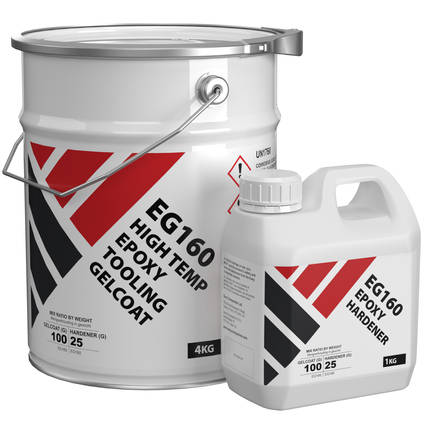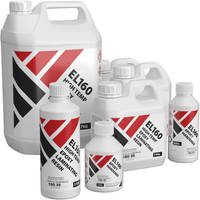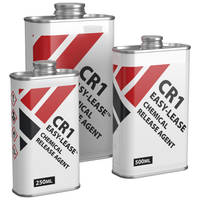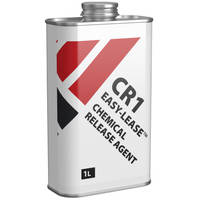Need any help or advice?+44 (0)1782 454499
Downloads (3)
This is a chemical product. Before storage or use you must download and read the accompanying safety and technical datasheets.
| Safety Datasheet (SDS) - EN | ||
| Safety Datasheet (SDS) - NL | ||
| Technical Datasheet (TDS) |
Specification
Product Data
| Colour | Grey | |
|---|---|---|
| Chemistry / Material | Epoxy | |
| Viscosity | 15000 | mPa.s |
| UV Resistance | Moderate | |
| Brand | Easy Composites | |
| Shelf Life | 12 | Months |
Cured Mechanical Properties
| Max Service Temp | 125 | °C |
|---|---|---|
| Hardness | 83 (Hard) | Shore D |
| Flexibility | Hard / Rigid | |
| Tg Onset (DMA) | 160 | °C |
Pot Life and Cure Times
| Pot Life (Typical) | 30 | mins |
|---|---|---|
| Initial Cure Time | 24 | Hrs |
General Properties
| Gross Weight | 5.5 | kg |
|---|
Shipping Information
Restrictions
This product is classed as dangerous goods for transport.
It can be shipped to all mainland EU countries, Ireland, Balearic Islands, Corsica, Sicily and Sardinia.
Unfortunately, for the time being we are unable to ship dangerous goods to Cyprus, Malta, the Canary Islands, Ceuta, Melilla, Jan Mayan and Svalbard.
For a full information regarding the shipment of dangerous goods, see our delivery information page.
Package Size
There are no package size restrictions or surcharges for this product.
Delivery Cost
To find the delivery cost of this item to your address, add it to your basket and then use the instant shipping calculator on the basket page.
EG160 High Temp Epoxy Tooling Gelcoat
- EP-G160-5
Hazardous
- No reviews
EG160 is a specialist brush-applied epoxy tooling gelcoat suitable for high temperature use up to 160°C. It is recommended when hand laminating tools/moulds that need a high service temperature, including moulds for use with prepregs such as XPREG® XC110.
Sold as a kit (resin and hardener). Available to buy online in 1kg or 5kg kits.
PRODUCT VERSIONS
Kit Size
AVAILABILITY:2 in stock available for immediate shipping
We won’t be beaten on price!
If you believe you’re buying an equivalent product cheaper elsewhere, contact us to discuss your requirements.
EG160 high temperature tooling gelcoat is an advanced epoxy gelcoat designed primarily for use in the production of high temperature moulds/tools for prepreg and resin infusion. EG160 uses a unique unfilled formulation which results in superior surface finish and polishability whilst still achieving excellent stability at service temperatures up to 160°C.
EG160 is applied by brush onto the pattern or master mould. The medium viscosity of the gelcoat makes it easier to apply at an even thickness whilst it is sufficiently thixotropic to allow application onto vertical surfaces.
The high temperature epoxy gelcoat is typically backed up using either EMP160 High Temp Epoxy Moulding Paste or EL160 High Temp Epoxy Laminating Resin (and suitable reinforcement) to produce a dimensionally stable, high service temperature mould or component.
Typical Uses
- Gelcoat on moulds for prepreg manufacture (see service temperature notes above)
- Gelcoat on moulds for high temperature epoxy infusion
- Gelcoat on high service temperature epoxy components
How to Buy
EG160 is available to buy online in 1kg and 5kg packs. Please choose the pack-size you require from the drop-down list at the top of the page.
Further Information
Initial Cure
EG160 can be cured to a demouldable state in 24hrs at 25C but at this stage can be brittle and prone to cracking during demoulding of more complex mould shapes. Therefore, in most cases, it is recommended to conduct the initial cure at 40C (whereby the cure time can be reduced to 12hrs). Conducting the initial cure at 40C is low enough to avoid distortion of the pattern whilst still curing the resin to an adequately non-brittle state to demould without risk of damage.
Recommended: 12hrs @ 40C
Alternative: 24hrs (min) @ 25C - Warning: Resin will be very brittle before post-cure
Effect of Gelcoats on Flat Moulds at Temperature
It should be noted that the use of any gelcoat (including EG160) on moulds intended for high temperature use will introduce a certain amount of 'imbalance' to the laminate, whereby the unreinforced gelcoat will have a slightly different coefficient of thermal expansion than the reinforced backing. Although often not noticeable on many mould geometries, this effect can result in noticeable temperature distortion on particularly large or flat moulds. In such cases, it is often preferable to forgo a gelcoat altogether.
Video Tutorial and Demonstration
In this video we demonstrate how to hand laminate a mould using our EG160 High Temperature Epoxy Tooling Gelcoat and our EMP160 High Temperature Epoxy Mould Making Paste.
Hand Laminating a High Temperature Mould
Tooling/Moulds for XPREG® Prepregs
EG160 is ideally suited as the surface layer on composite moulds intended for use with the XPREG® range of prepregs. Moulds can be made by hand-layup (using either EP160 paste or EL160 laminating resin and suitable reinforcement) and will be dimensionally stable and reliable at the optimum cure temperature of 120°C for most XPREG® prepregs.
Note: Although EG160 is temperature-stable up to 160°C, when laminating moulds by hand (i.e. without vacuum consolidation), the maximum service temperature of the mould should not exceed 125°C. See technical datasheet for more details.
Backing up EG160 - Compatible Reinforcements
EG160 should only be backed-up using a compatible epoxy-based system such as further layers of EG160, EMP160 High Temp Epoxy Moulding Paste or EL160 High Temp Epoxy Laminating Resin. Compatibility with other high temperature epoxy resins is possible but not guaranteed. See technical datasheet for further details and full instructions.
Using Cured Moulds
Moulds/tools made using EG160 gelcoat can be used to produce parts using epoxy, polyester and vinylester resin systems, including prepregs (subject to maximum service temperature). A suitable release agent is required.
The shelf life of the resin and hardener is 12 months from date of manufacture.
EG160 high temperature tooling gelcoat is an advanced epoxy gelcoat designed primarily for use in the production of high temperature moulds/tools for prepreg and resin infusion. EG160 uses a unique unfilled formulation which results in superior surface finish and polishability whilst still achieving excellent stability at service temperatures up to 160°C.
EG160 is applied by brush onto the pattern or master mould. The medium viscosity of the gelcoat makes it easier to apply at an even thickness whilst it is sufficiently thixotropic to allow application onto vertical surfaces.
The high temperature epoxy gelcoat is typically backed up using either EMP160 High Temp Epoxy Moulding Paste or EL160 High Temp Epoxy Laminating Resin (and suitable reinforcement) to produce a dimensionally stable, high service temperature mould or component.
Typical Uses
- Gelcoat on moulds for prepreg manufacture (see service temperature notes above)
- Gelcoat on moulds for high temperature epoxy infusion
- Gelcoat on high service temperature epoxy components
How to Buy
EG160 is available to buy online in 1kg and 5kg packs. Please choose the pack-size you require from the drop-down list at the top of the page.
Further Information
Initial Cure
EG160 can be cured to a demouldable state in 24hrs at 25C but at this stage can be brittle and prone to cracking during demoulding of more complex mould shapes. Therefore, in most cases, it is recommended to conduct the initial cure at 40C (whereby the cure time can be reduced to 12hrs). Conducting the initial cure at 40C is low enough to avoid distortion of the pattern whilst still curing the resin to an adequately non-brittle state to demould without risk of damage.
Recommended: 12hrs @ 40C
Alternative: 24hrs (min) @ 25C - Warning: Resin will be very brittle before post-cure
Effect of Gelcoats on Flat Moulds at Temperature
It should be noted that the use of any gelcoat (including EG160) on moulds intended for high temperature use will introduce a certain amount of 'imbalance' to the laminate, whereby the unreinforced gelcoat will have a slightly different coefficient of thermal expansion than the reinforced backing. Although often not noticeable on many mould geometries, this effect can result in noticeable temperature distortion on particularly large or flat moulds. In such cases, it is often preferable to forgo a gelcoat altogether.
Video Tutorial and Demonstration
In this video we demonstrate how to hand laminate a mould using our EG160 High Temperature Epoxy Tooling Gelcoat and our EMP160 High Temperature Epoxy Mould Making Paste.
Hand Laminating a High Temperature Mould
Tooling/Moulds for XPREG® Prepregs
EG160 is ideally suited as the surface layer on composite moulds intended for use with the XPREG® range of prepregs. Moulds can be made by hand-layup (using either EP160 paste or EL160 laminating resin and suitable reinforcement) and will be dimensionally stable and reliable at the optimum cure temperature of 120°C for most XPREG® prepregs.
Note: Although EG160 is temperature-stable up to 160°C, when laminating moulds by hand (i.e. without vacuum consolidation), the maximum service temperature of the mould should not exceed 125°C. See technical datasheet for more details.
Backing up EG160 - Compatible Reinforcements
EG160 should only be backed-up using a compatible epoxy-based system such as further layers of EG160, EMP160 High Temp Epoxy Moulding Paste or EL160 High Temp Epoxy Laminating Resin. Compatibility with other high temperature epoxy resins is possible but not guaranteed. See technical datasheet for further details and full instructions.
Using Cured Moulds
Moulds/tools made using EG160 gelcoat can be used to produce parts using epoxy, polyester and vinylester resin systems, including prepregs (subject to maximum service temperature). A suitable release agent is required.
The shelf life of the resin and hardener is 12 months from date of manufacture.
Specification
Product Data
| Colour | Grey | |
|---|---|---|
| Chemistry / Material | Epoxy | |
| Viscosity | 15000 | mPa.s |
| UV Resistance | Moderate | |
| Brand | Easy Composites | |
| Shelf Life | 12 | Months |
Cured Mechanical Properties
| Max Service Temp | 125 | °C |
|---|---|---|
| Hardness | 83 (Hard) | Shore D |
| Flexibility | Hard / Rigid | |
| Tg Onset (DMA) | 160 | °C |
Pot Life and Cure Times
| Pot Life (Typical) | 30 | mins |
|---|---|---|
| Initial Cure Time | 24 | Hrs |
General Properties
| Gross Weight | 5.5 | kg |
|---|
Uncured resins are classed as dangerous goods and would need to be disposed of correctly. For domestic users, usually your local council recycling centre will have a disposal service for such chemicals or containers.
Because cured resins are inert and safe for disposal it's often easiest to mix un-needed or out-of-date resin and hardener together to cure them. Once cured they can be disposed of with general waste.
Unlike other resin systems such as polyester or vinylester, it's very important to get the mix ratios accurate with epoxies. If you get the mix ratio wrong by a small amount (let's say a couple of grams on a small mix) then the resin will still cure but the mechanical properties won't be quite as good as they would have been if the mix ratio had been exactly right. However, if you were to be out by anything more than a few grams then you might find that the resin would not be properly hard when cured and/or may have a tackiness to the finish. This would result in a much weaker repair and needs to be avoided by careful measurements.
No, we wouldn’t suggest Epoxy Resins for lining a fuel tank. In general, epoxies have good resistance to petrol and many of the chemicals and additives found within pump fuel however the ethanol in fuel is known to cause problems over time and so specialist tank lining resins (often novalac vinylester based) should be used instead. One such product is GTS 1750 which is sold by Caswell Europe.
No, this epoxy in common with other epoxies does not attack expanded polystyrene
We have not specifically saught FDA (or similar) approval for this resin system so if you were to make these plates commercially then you would either need to make a plate using this resin system and then have it tested and approved safe for food use or use a different resin system that has specifically been approved for food use. Mixed and cured fully and properly the resulting plastic should be stable and non-toxic but testing would be required to prove this. Regarding being dishwasher safe; a dishwasher is a very harsh environment (abrasive, high temperatures, caustic) and so I think it would be quite hard on any resin system. By all means conduct your own tests but I would strongly recommend that a carbon fibre plate was not marketed as 'dishwasher safe'.
Above the HDT of a resin system it will soften slightly and its mechanical properties will start to fall away however a thermosetting plastic (like epoxy) is NOT a thermoformable plastic so it will not start to flow again such that you could melt it out of your part. It's more likely to become slightly soft and then possible more brittle again before eventually starting to burn if you too the temperature high enough. It sounds to me like you need a thermoformable plastic (aka a thermoplastic) with a relatively low melting point. I'd suggest something like PCL.
An elevated temperature post-cure is not required for parts made with epoxy resin however, post curing parts will improve the mechanical properties of the resin (and therefore the part) and so if you have the means to do it then it's certainly recommended. One major advantage to post-curing epoxy is that you will raise the HDT (heat distortion temperature) of the part meaning that it's less likely to soften or distort in higher temperatures. This can be particularly important for parts like a vehicle panel (i.e. hood/bonnet) which could get very hot in the sun. Without a post-cure there is a good chance that the part would effectively post-cure itself 'in situe' when it's in direct sunlight which can cause the resin to soften, sink and then re-harden. When this happens to a fitted part it's likely to distort the surface finish. A part that had been post-cured prior to installation would not have this problem.
Epoxy resins have very little odour and so it's quite viable to use them indoors (i.e. in your house) without upsetting anyone. The resin is almost completely odourless and the hardener has an amonia smell which doesn't really carry or linger.
In this respect epoxies are very different to polyester and vinylester resin which has a very strong smell and cannot realistically be used indoors. As always, you should still follow safety precautions and ensure adequate ventilation of your work area.
Although generally cured epoxies are non-hazardous, none of the products we have are certified food safe and thus we cannot recommend their use with food products.
We recommend Acetone. The brushes must be cleaned before the resin has cured. If you can’t get hold of acetone it’s also possible to use methylated spirits or neat alcohol.
In really simple terms you can think of 1kg of the Epoxy Resin as being 1L. If you want to be really exact (for example if you want to mix the resin and the hardener by volume and not by weight (which we don't recommend because it's unnecessarily complicated) then the relative density of the resin and the hardener, and the mixed product, can be found on the technical datasheet.
We can send any quantity of resin to Portugal. We would use a TNT Road service. To find the shipping cost for any item, simply add it to your basket and then click the 'Estimate Shipping' button on the basket page. The price will then be shown once you chose your shipping country (Portugal).
The B stage of the cure is when the resin has cured enough to be firm but still tacky. When touching with a gloved finger, the resin should feel tacky but not leave any residue on the glove.
Epoxy is sensitive to low temperatures so we would not attempt to try and cure the resin at very low temperatures such as below 15 °:C. At those temperatures, the cure time will be lengthened considerably.
One of the most significant problems caused by low temperatures (much below 20°C) is that the resin will be considerably thicker which affects its ability to self-degas after pouring.
Also, curing epoxies are hydroscopic so the low temperature environment may well leave the resin vulnerable to absorbing moisture, especially if the environment is relatively damp or high in humidity as can be found in some outdoor workshops or home garages.
As a result, for best results we always recommend working in an environment that is 20°C or above.
Good question. The timing of the post-cure is definitely not critical in the same way, for example, that the 'B-stage' is when making the moulds in the first place would, but the post-cure should still be undertaken whilst the resin systems are still continuing to harden. For the EG160/EMP160/EL160 system this would mean ideally undertaking the post-cure within around 7 days of reaching initial cure at room temperature.
The shelf life of the resin and hardener is 12 months.
In the video where we made a high temp mould from resin infusion, we didn't actually use a gel coat but infused straight onto the pattern. Whilst it is possible to include a gelcoat, there are a couple of things to consider.
- Adding in a second material can cause distortion and warping as the resin and gelcoat will have a slightly different CTE, for very precise moulds, this may be an issue.
- Ideally you want to be infusing whilst the gelcoat is still in the ‘B’ stage window to avoid delamination at a later date. This means that you need to get the fabric laid up, all of the consumables secured and begin infusing in a much more condensed time window. Depending on temperature, this window will lengthen and shorten but typically would be around a few hours. Whilst this may be feasible for smaller moulds it will add more pressure and stress to a process which can already be tricky.
In the case of our example, we chose not to include the gelcoat and still achieved great results from the mould.
Due to the density of the product, a rule of thumb that works well is that 1kg of gelcoat spread over 1sqm will be 1mm thick. This means each 0.5mm layer will need 500g per square meter and the final 0.25mm thick layer needs 250g/sqm. Thus overall you should allow 1.25kg of gelcoat per square meter coverage. This means a 1kg pack will give 0.8sqm coverage.
Yes you can slightly warm the resin to make it easier to apply. However that will reduce the pot life so the gelcoat will need to be applied reasonably quickly.
For a wet lay up using a fabric and the EL160 high temperature resin, no coupling coat stage is needed. The EL160 is applied after the 2nd layer of EG160 Gelcoat has gone firm but tacky.
ASK YOUR OWN QUESTION
Customer Product Reviews for EG160 High Temp Epoxy Tooling Gelcoat
SUBMIT YOUR OWN PRODUCT REVIEW
We publish all reviews for verified purchases. Submit your own review and help other customers with their choices.SUBMIT YOUR OWN PRODUCT REVIEW
We publish all reviews for verified purchases. Submit your own review and help other customers with their choices.Shipping Information
Restrictions
This product is classed as dangerous goods for transport.
It can be shipped to all mainland EU countries, Ireland, Balearic Islands, Corsica, Sicily and Sardinia.
Unfortunately, for the time being we are unable to ship dangerous goods to Cyprus, Malta, the Canary Islands, Ceuta, Melilla, Jan Mayan and Svalbard.
For a full information regarding the shipment of dangerous goods, see our delivery information page.
Package Size
There are no package size restrictions or surcharges for this product.
Delivery Cost
To find the delivery cost of this item to your address, add it to your basket and then use the instant shipping calculator on the basket page.
RELATED PRODUCTS
CUSTOMERS ALSO PURCHASED
RELATED PRODUCTS
CUSTOMERS ALSO PURCHASED
100% SECURE
PAYMENT METHODS
Easy Composites EU B.V., registered in the Netherlands 73601195. All content copyright (C) Easy Composites Ltd, 2025. All rights reserved.




